Abstract
The major drawback of the conventional chaotic ON–OFF keying (COOK) scheme is that the transmitted signal energy is not constant due to the non-periodic nature of the chaotic sequences. These chaotic sequences increase the amount of noise present in the received signal and degrade the system performance under multipath fading channel conditions. Moreover, in COOK scheme, the optimum threshold for symbol detection depends on the Signal to Noise Ratio (SNR) available at the detector input. In this paper, a noise reduction COOK scheme is proposed for improved performance. In this scheme, for transmitting binary bit ‘1’ \(\frac{\beta }{R}\) distinct chaotic samples are generated and each sample is repeated R times to get a required spreading sequence length of β and no signal is being transmitted during binary bit ‘0’. For demodulation of the transmitted data, each of the R identical samples are averaged, correlated with itself and summed over the bit duration \(T_{b}\) where \(T_{b} = \frac{\beta }{R}T_{c}\) to recover the transmitted data. The averaging operation over R identical samples reduces the effect of noise present in the received signal and improves the performance of the system over noisy channels. Closed form expression for bit error rate (BER) of the proposed NR-COOK system is derived and analyzed under multipath fading channel and are validated through simulation results to demonstrate performance improvement over conventional non coherent schemes.









Similar content being viewed by others
References
Eisencraft, M., Attux, R., & Suyama, R. (2013). Chaotic signals in digital communications. Boca Raton: CRC Press.
Lau, F. C. M., & Tse, C. K. (2003). Chaos-based digital communication systems. New York: Springer.
Kolumban G., Vizvari G. K., et al. (1997). Differential chaos shift keying: A robust coding for chaos communication. In Proceedings of International Workshop on Nonlinear Dynamics of Electronics Systems (pp. 87–92). Seville, Spain
Kolumban G., Kennedy M. P., and Jako Z. (1997). FM-DCSK: A new and robust solution to chaos communication. In Proceedings of International Symposium on Non-Linear Theory and Its Application (NOLTA ’97) (pp. 117–120). Hawaii, USA
Kaddoum, G., Soujeri, E., Arcila, C., and Eshteiwi, K. (2015). I-DCSK: An improved noncoherent communication system architecture. In IEEE Transactions on Circuits and Systems—II: Express Briefs, (vol. 62, pp. 901–905)
Kaddoum, G. (2016). Design and performance analysis of a multiuser OFDM based differential chaos shift keying communication system. IEEE Transactions on Communications,64(1), 249–260.
Kaddoum, G., & Nijsure, Y. (2016). Design of short reference non-coherent chaos-based communication system. IEEE Transactions on Communications,64(2), 680–689.
Kaddoum, G., & Soujeri, E. (2016). NR-DCSK: A noise reduction differential chaos shift keying systems. IEEE Transactions on Circuits and Systems II: Express Briefs,63(7), 648–652.
Georges, K., Tran, H. V., Kong, L., & Atallah, M. (2017). Design of simultaneous wireless information and power transfer scheme for short reference DCSK communication systems. IEEE Transactions on Communications,65(1), 431–443.
Cai, G., Yi Fang, Y., & Han, G. (2017). Design of an adaptive multiresolution M-ary DCSK system. IEEE Communications Letters,21(1), 60–63.
Herceg, M., Kaddoum, G., Vranjeˇs, D., & Soujeri, E. (2018). Permutation Index DCSK modulation technique for secure multiuser high-data-rate communication systems. IEEE Transactions on Vehicular Technology,67(4), 3001–3011.
Hu, W., Wang, L., and Kaddoum, G. (2017). Design and performance analysis of a differentially spatial modulated chaos shift keying modulation system. In IEEE Transactions on Circuits and Systems—II: Express Briefs (vol. 64, pp. 1302–1306)
Kolumban, G., Kennedy, M. P., & Chau, L. O. (1997). The role of synchronization in digital communications Chaos—Part I: Fundamentals of digital communications. IEEE Transactions on Circuits and Systems,44(10), 927–936.
Papoulis, A. (1984). Probability, random variables, and stochastic processes (2nd ed.). New York: McGraw Hill.
Shynk, J. J. (2012). Probability, random variables, and random processes: Theory and signal processing applications. Hoboken: Wiley.
Rappaport, T. S. (2013). Wireless communications: Principles and practice (2nd ed.). London: Pearson.
Ng, E. W., & Geller, M. (1969). A table of integrals for the error functions. Journal of Research of the National Bureau of Standards-B,75B, 149–163.
Jaeseung, S., Kim, H. et al. (2005). Performance analysis of non-coherent chaotic on-off keying systems. In Proceedings of International Technical Conference on Circuits and Systems, Computers and Communications (pp. 503–504). Jeju, Korea
Lee, K., Kyeong, S., Kim, J., Kim, Y., and Park, H. (2006). The chaotic on-off keying with guard interval for ultra-wideband communication. In Proceedings of IEEE VTS Asia Pacific Wireless Communications Symposium (pp. 1–4). Japan
Nizar, A., Sumesh, E. P., & Vidhya, L. R. (2015). A threshold enhancement technique for chaotic on-off keying scheme signal processing. An International Journal on Signal Processing,9(3), 25–27.
Author information
Authors and Affiliations
Corresponding author
Additional information
Publisher's Note
Springer Nature remains neutral with regard to jurisdictional claims in published maps and institutional affiliations.
Rights and permissions
About this article
Cite this article
Sangeetha, M., Bhaskar, V. Improved Non-coherent Communication Systems Using Noise Reduction Chaotic ON–OFF Keying (NR-COOK) Techniques. Wireless Pers Commun 113, 1297–1314 (2020). https://doi.org/10.1007/s11277-020-07280-8
Published:
Issue Date:
DOI: https://doi.org/10.1007/s11277-020-07280-8




